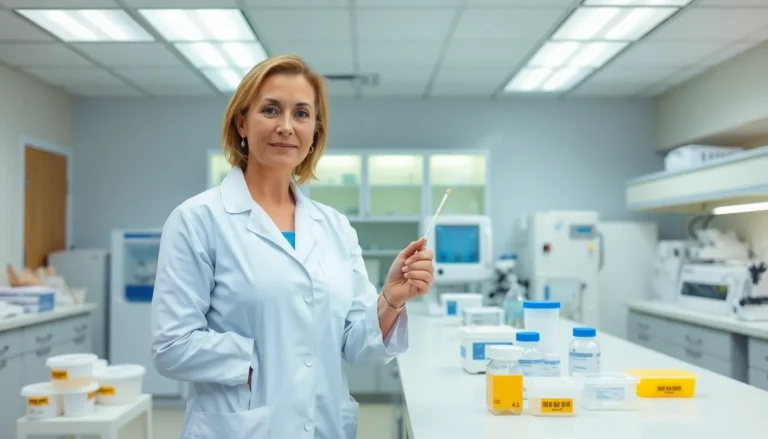In a world where germs are the new celebrities, viral culture swabs are the unsung heroes of the microbiological realm. They swoop in like a superhero team, ready to capture and identify those pesky viruses lurking in the shadows. Imagine a tiny cotton swab, armed with the power to unveil the microscopic world that can wreak havoc on health. It’s like a detective on a mission, seeking out the culprits behind illnesses.
Table of Contents
ToggleOverview of Viral Culture Swabs
Viral culture swabs are critical in diagnosing and understanding viral infections. These swabs collect samples from various bodily fluids, including nasal secretions and throat swabs. Lab technicians then use these samples to grow the virus in a controlled environment. This process identifies the specific virus causing an infection.
Accuracy in testing plays a vital role in patient care. When clinicians utilize viral culture swabs, they receive precise information about the pathogen. Identifying the virus enables the medical team to choose the appropriate treatment.
Speed also matters. Many viral culture techniques yield results within a few days, allowing timely intervention. Active monitoring of viral growth in culture helps recognize outbreaks early, facilitating public health measures.
Safety protocols during collection are paramount. Health professionals adhere to standard procedures to minimize contamination and ensure results are valid. Personal protective equipment, including gloves and masks, is essential during sample collection.
Viral culture swabs complement other diagnostic methods. Combining viral cultures with serological tests enhances the understanding of infections. This integrated approach offers a comprehensive picture of viral activity.
Cost efficiency is another advantage. While some viral tests can be expensive, culture methods often provide a cost-effective alternative for diagnosis. Facilities can utilize these swabs without extensive resources, making them accessible to various healthcare settings.
Viral culture swabs are indispensable tools in identifying and managing viral infections. By accurately detecting pathogens, these swabs contribute to effective healthcare outcomes.
Importance of Viral Culture Swabs
Viral culture swabs serve critical roles in diagnosing and managing viral infections. Their diagnostic utility and public health implications highlight their significance in modern healthcare.
Diagnostic Utility
Viral culture swabs offer precise results for identifying specific pathogens. Samples collected from nasal secretions or throat swabs grow viruses in laboratory settings, leading to accurate diagnoses. Clinicians rely on these tests to select tailored treatments, improving patient outcomes. Timing matters; many culture methods yield results within a few days. Rapid diagnosis facilitates timely interventions, enhancing the effectiveness of medical responses. Diagnostic accuracy with viral culture swabs also complements serological tests, providing a complete understanding of infections.
Public Health Implications
Viral culture swabs contribute significantly to public health strategies. Early detection of viral pathogens aids in identifying outbreaks before they escalate. Health authorities use this data to implement control measures, mitigating the spread of infections in communities. Additionally, accurate data from culture swabs informs vaccination strategies and resource allocation. Their cost efficiency allows for broader access to diagnoses, which is crucial in varied healthcare settings. Effective management of viral infections hinges on the accurate, timely information provided by these indispensable diagnostic tools.
Types of Viral Culture Swabs
Different types of viral culture swabs exist, each designed for specific sampling needs. These swabs help in the accurate diagnosis of viral infections.
Nasopharyngeal Swabs
Nasopharyngeal swabs target the nasopharynx, the area located behind the nose and above the back of the throat. These swabs effectively capture viral particles from respiratory secretions. Health professionals insert a thin, flexible swab into the nostril gently to obtain samples. This method proves vital for identifying respiratory viruses like influenza and SARS-CoV-2. Additionally, nasopharyngeal swabs often yield high viral loads, enhancing the chances of successful virus culture growth.
Oropharyngeal Swabs
Oropharyngeal swabs sample the throat, specifically the oropharynx region, which includes the back of the mouth and tongue. These swabs provide valuable information for detecting viruses that affect the throat and upper respiratory tract. Professionals use a similar swab technique, gently rubbing the swab against the tonsils and the back of the throat. Oropharyngeal swabs can identify pathogens such as COVID-19 and streptococcus bacteria effectively. This method complements nasopharyngeal swabbing to ensure a comprehensive assessment of throat-related infections.
Other Swab Types
Other swab types include conjunctival, rectal, and vaginal swabs, each serving a unique purpose in viral diagnosis. Conjunctival swabs target eye infections, effectively identifying viruses like adenovirus. Rectal swabs help in diagnosing enteric viruses, while vaginal swabs focus on infections affecting the reproductive system. These specialized swabs allow healthcare professionals to gather samples from various body sites, broadening the spectrum of viral detection. Choosing the appropriate swab type enhances the accuracy and efficiency of viral culture techniques in diagnosing infections.
Best Practices for Sample Collection
Effective sample collection ensures accurate viral diagnostics. Proper techniques and preparations play a vital role in obtaining reliable results.
Pre-Collection Preparations
Before collection, health professionals prepare by gathering necessary equipment. Using sterile viral culture swabs is essential for contamination prevention. They also check the expiration dates on swabs and any media used for sample transport. Personal protective equipment, such as gloves and masks, protects both the worker and patient. Additionally, instructing patients on the procedure helps reduce anxiety and improves cooperation. Ensuring the environment is clean and well-lit fosters an efficient collection process.
Collection Techniques
Adhering to proper collection techniques maximizes sample quality. Selecting the appropriate swab type caters to specific diagnostic needs. For nasopharyngeal swabs, insertion should reach the posterior nasopharynx for optimal sample retrieval. Oropharyngeal swabs require swabbing of the tonsillar areas and the back of the throat. Ensuring consistent sample collection duration enhances viral yield. Immediately placing collected samples in a sterile container preserves viability. Transporting samples at the correct temperature prevents degradation, facilitating accurate laboratory analysis.
Challenges in Viral Culture Swabbing
Viral culture swabbing presents several challenges that can impact diagnostic accuracy. Contamination poses a significant risk; any foreign agents can compromise sample integrity. Practitioners must adhere to strict protocols to maintain a sterile environment throughout the collection process. Inadequate insertion depth also affects sample quality. Techniques for nasopharyngeal and oropharyngeal swabbing require precision to gather sufficient material.
Transport conditions frequently present additional hurdles. Ensuring proper temperature and immediate placement in sterile containers is crucial for preserving sample viability. Delayed transportation increases the likelihood of sample degradation, leading to inaccurate results. Furthermore, securing qualified personnel for the collection process remains essential. Trained technicians possess the expertise needed to perform effective swabbing while minimizing risk.
Variability in swab types can generate confusion. Choosing the appropriate swab for specific viral pathogens enhances diagnostic accuracy but complicates the selection process for healthcare providers. Additionally, training staff on the latest best practices is vital for maintaining high-quality standards. Regular updates on techniques and procedures keep personnel informed and skilled.
Patient cooperation also plays an important role. Some individuals may experience discomfort during the swabbing process, which can lead to resistance or incomplete samples. Effective communication about the procedure can help alleviate concerns and increase compliance. Addressing these challenges directly affects the reliability of viral culture swabbing and its overall impact on patient care.
Viral culture swabs play a pivotal role in modern healthcare by enhancing the accuracy of viral diagnostics. Their ability to identify specific pathogens quickly supports timely treatment decisions and effective public health interventions. By integrating these swabs with other diagnostic methods, healthcare professionals can achieve a comprehensive understanding of viral infections.
The challenges associated with sample collection and contamination underscore the importance of trained personnel and strict adherence to protocols. As healthcare continues to evolve, the significance of viral culture swabs in managing viral outbreaks and improving patient outcomes cannot be overstated. Their ongoing use will remain essential in the quest to safeguard public health and respond effectively to emerging viral threats.



